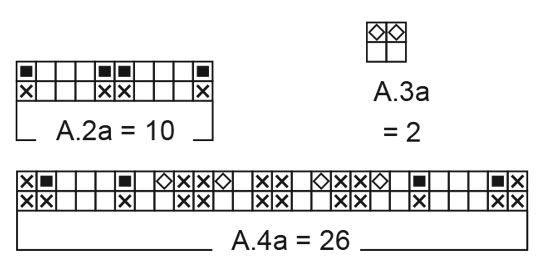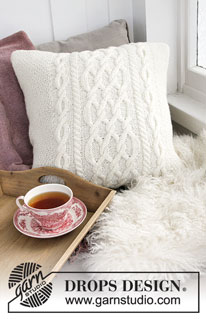Comments / Questions (12)
![]() Berit Rustad wrote:
Berit Rustad wrote:
Det skal iflg oppskriften legges opp 184 masker. Etter to riller skal jeg starte med ulike mønster og plutselig skal det være 204 masker. Men... jeg ser ikke hvordan det plutselig skjer at det er 20 flere masker på runden. Står ikke noe at man skal legge ut fra 184 til 204 masker.
09.02.2023 - 21:32DROPS Design answered:
Hei Berit, Du har ruter med svart firkant i diagrammene, som er å strikke 2 vrang i samme masken (øker 1 maske) og ruter med en åpen diamant som er å strikke 2 rett i samme masken (1 maske økt). Når du får med alle disse rutene får du økt 20 masker. God fornøyelse!
10.02.2023 - 08:39
![]() Christina Scheller wrote:
Christina Scheller wrote:
Die Anleitung ist sehr irreführend! Bitte streicht doch die Bemerkung bei "Muster" mit den Hin und Rückreihen und ändert die Diagramme dementsprechend. Auch wäre es besser wenn im Text nicht von der nächsten Runde die Rede wäre sondern explizit von der dritten Runde mit Anfang der B Diagramme. Ich stricke wohl zu locker, obwohl die Maschenprobe in Ordnung war. Hab das Kissen wieder aufgezogen weil das Perlmuster mir nicht gefiel.
14.10.2021 - 15:38
![]() Yvonne wrote:
Yvonne wrote:
Bonjour, J'ai découpé la grille et recollé en insérant les lignes manquantes. Le coussin (très beau) est en cours de finition. Très bonne semaine à vous ! Cordialement
19.07.2021 - 08:35
![]() Yvonne wrote:
Yvonne wrote:
Bonjour, Je réitère mon message du 4 juillet concernant "Le diagramme A 2b erroné : une erreur est produite 3 fois : La 1ère torsade affiche bien 5 rangs (env-end-env-end-env) avant le prochain croisement des mailles. La 2nde ne comporte que 4 rangs (env-end-env-end) et l'on ne peut croiser/tordre qu'après un rang envers La 3ème torsade est OK, la 4ème est fausse et la 5ème est OK La 6ème qui commence en haut du diagramme et reprend au rang 1 est fausse : 4 rangs.
17.07.2021 - 13:24DROPS Design answered:
Bonjour Yvonne et merci pour votre message, votre remarque a été transférée à nos stylistes et une correction sera probablement faite après les vacances. Merci pour votre patience. Bon tricot!
19.07.2021 - 08:22
![]() Yvonne wrote:
Yvonne wrote:
Bonjour, Le diagramme A 2b est erroné, une erreur est produite 3 fois : La 1ère torsade affiche bien 5 rangs (env-end-env-end-env) avant le prochain croisement des mailles. La 2nde ne comporte que 4 rangs (env-end-env-end) et l'on ne peut croiser/tordre qu'après un rang envers La 3ème torsade est OK, la 4ème est fausse et la 5ème est OK La 6ème qui commence en haut du diagramme et reprend au rang 1 est fausse : 4 rangs
04.07.2021 - 22:32
![]() Sarah wrote:
Sarah wrote:
Ich möchte das Kissen gern nachstricken. Bisher habe ich Zopfmuster noch nicht in Runden gestrickt. Daher meine Frage: Wieso stricke ich die Diagramme mal von links, mal von rechts, wenn ich doch in Runden stricke? Müsste ich da nicht immer aus der gleichen Richtung stricken? Danke schon mal für die Hilfe!
28.02.2019 - 06:14DROPS Design answered:
Liebe Sarah, die Diagramme zeigen alle Reihen bzw Runden vom Muster, dh beginnen Sie an der unteren rechten Ecke und lesen Sie jede Runde rechts nach links. Viel Spaß beim stricken!
28.02.2019 - 09:45
![]() Herlinde Vos wrote:
Herlinde Vos wrote:
Kunnen die kussens ook gebreid worden met rechte naalden ipv rondbreinaalden?
25.11.2018 - 18:38DROPS Design answered:
Dag Herlinde,
Dat kan, maar dan moet je de kussens in 2 delen breien (een voorkant en een achterkant), die je op het eind aan elkaar naait. Via deze link vind je meer informatie over hoe je een patroon aan kunt passen om met rechte naalden te breien. Dit kun je ook toepassen op een kussen.
28.11.2018 - 12:33
![]() Daniela wrote:
Daniela wrote:
In der Anleitung werden 450g (900m) Drops Karisma gefordert, ich habe nur 230g (460m) Drops Lima benötigt!!! Die Maschenprobe passt. Das Kissen ist sehr schön geworden.
15.08.2018 - 22:30
![]() Anne wrote:
Anne wrote:
Hello again. It appears that Anna already asked this question in another language and the response implies that it was an error in the pattern that has been corrected. However, I do not see any corrected patterns here. The pattern implies that the increase occurs after round one, but your response indicates that it happens after round two. Do I use the "a" patterns for two rows before proceeding to the "next round" with the "B" patterns?
06.08.2018 - 17:15DROPS Design answered:
Dear Anne, you will increase a total of 20 sts in the 2nd row of A.2a-A.4a: 4 sts in each A.2a (= 8 sts), 2 sts in each A.3a (= 4 sts) and 8 sts in A.4a, = 184+ (8+4+8) = 204 sts. Happy knitting!
07.08.2018 - 08:40
![]() Anne wrote:
Anne wrote:
Still confused....how do you get 204 stitches after round one, when none of the round one patterns have any increases from the initial 184 stitches?
06.08.2018 - 03:30DROPS Design answered:
Dear Anne, when working diagrams A.2a to A.4a you will increase sts in 2nd row each diagram - see 7th and 8th diagram key. Happy knitting!
06.08.2018 - 09:40
Polar Days Pillow#polardayspillow |
||||||||||||||||||||||||||||
 |
 |
|||||||||||||||||||||||||||
Knitted pillow with cables and moss stitch. Piece is knitted in DROPS Karisma.
DROPS 183-36 |
||||||||||||||||||||||||||||
|
INFORMATION FOR PATTERN: GARTER STITCH (worked in the round): 1 ridge = 2 rounds. Knit 1 round and purl 1 round. PATTERN: See diagrams A.1 to A.4. Diagrams show all rows in pattern seen from the right side. CAST-OFF TIP: To avoid a tight cast-off edge you may use a needle ½ size larger. ---------------------------------------------------------- PILLOW: Worked in the round on circular needle. Cast on 184 stitches on circular needle size 4 mm with Karisma. Work 2 ridges in GARTER STITCH - see explanation above. Insert 1 marker at the beginning of round and 1 marker after 90 stitches = the sides. Move markers upwards when working. REMEMBER THE KNITTING TENSION! Then work pattern according to diagram as follows: Work A.1 (= 2 stitches) over the first 20 stitches, A.2a (= 10 stitches), A.3a (= 2 stitches), A.4a (= 26 stitches), A.3a (= 2 stitches), A.2a (= 10 stitches), work A.1 (= 2 stitches) over the remaining 114 stitches. When A.2a to A.4a are done, there are 204 stitches on round. Work next round as follows: Work A.1 (= 2 stitches) over the first 20 stitches, A.2b (= 14 stitches), A.3b (= 4 stitches), A.4b (= 34 stitches), A.3b (= 4 stitches), A.2b (= 14 stitches), work A.1 (= 2 stitches) over the remaining 114 stitches. Repeat diagrams vertically. Continue in the round until A.4b has been worked 2 times vertically, then repeat the first 19 rounds in A.4b (see arrow in diagram). Knit 1 round and decrease 4 stitches over each A.2b, decrease 2 stitches over each A.3b and decrease 8 stitches evenly over cables in A.4b = 184 stitches. Purl 1 round, knit 1 round and purl 1 round. Cast off - read CAST-OFF TIP. ASSEMBLY: Fold piece at the markers. Sew top edge edge to edge in outer loops of edge stitches. Lay a pillow inside the casing and then sew in bottom edge. |
||||||||||||||||||||||||||||
Diagram explanations |
||||||||||||||||||||||||||||
|
||||||||||||||||||||||||||||

|
||||||||||||||||||||||||||||

|
||||||||||||||||||||||||||||

|
||||||||||||||||||||||||||||
Have you finished this pattern?Tag your pictures with #dropspattern #polardayspillow or submit them to the #dropsfan gallery. Do you need help with this pattern?You'll find 19 tutorial videos, a Comments/Questions area and more by visiting the pattern on garnstudio.com. © 1982-2025 DROPS Design A/S. We reserve all rights. This document, including all its sub-sections, has copyrights. Read more about what you can do with our patterns at the bottom of each pattern on our site. |
||||||||||||||||||||||||||||

































































Post a comment to pattern DROPS 183-36
We would love to hear what you have to say about this pattern!
If you want to leave a question, please make sure you select the correct category in the form below, to speed up the answering process. Required fields are marked *.